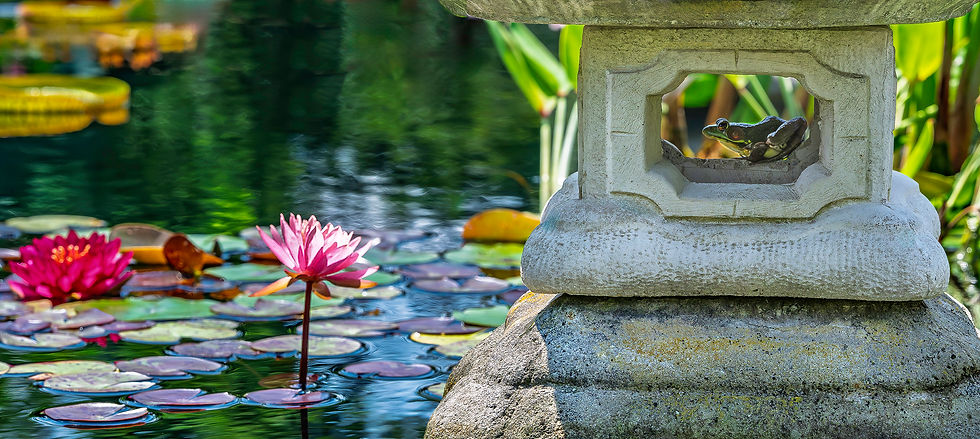Lotus in Japanese Garden Ponds
- Kevin Warren

- Jul 20
- 9 min read
Updated: 4 days ago

The Lotus: A Natural Wonder in Aquatic Gardens
Across tranquil ponds and water gardens worldwide, the lotus flower has long captured human imagination and respect. I believe that Lotus in Japanese Garden Ponds for their spiritual relationship to Buddhism and beauty are a perfect fit. Zen Buddhism emphasizes meditation and enlightenment through nature. Zen gardens, Karesansui or “dry landscape gardens are a prime example. The minimalist space of a zen garden is for quiet reflection, to connect with the spirituality of nature.
The lotus flower is culturally significant—from meticulously landscaped gardens in Japan, where it represents purity and clarity, to India, where it holds the distinction of national flower. In China, it symbolizes honesty and goodness, while ancient Egyptian culture revered it as a symbol of rebirth and regeneration. The native Nelumbo lutea is America’s largest wildflower.
Ask the Expert: Kelly Billing is changing the way water becomes a garden
In putting this story together, I had to find someone who knew the Lotus as well as anyone. The person I found is Kelly Billing. Ms. Billing is the former Director of the Board/Vice President for the International Water Lily & Water Garden Association (IWGS) as well as a Certified Professional Horticulturist. You can find out more about Kelly Billing at this link and let her help you with changing the way water becomes a garden for you.
Get to Know Kelly Billing

“My mom was a gardener. We would go for long walks in the woods. We knew every plant on the forest floor, every tree from May Apples to Partridge Berry to Birch to Oak. That's what we did. I got into this when my kids were young, and I learned through the passion of my children. My heart lies in growing things. I can't help it. The fulfillment that you get from watching miracles happen every day. I don't think most people understand that. To me, the Lotus growing from a seed that could be dormant for centuries is a miracle. If you come out here early in the morning as the flowers open, they usually have bumblebees in them. They sleep there at night. It's warm and dry. Yeah, it's pretty cool.” Personally, I think the many stories Kelly has to tell are pretty cool.
“I will say it’s (lotus) largely misunderstood and there’s a lack of information. Most people still think that Lotus is a tropical plant. There’s actually two species, an American and Asian.
American Lotus grows from Canada to the equator with an unchanged DNA stream, which is uncommon among plant material.
Anything that has migrated from a cold region to a hot region is going to have an alteration. The plant has modified their DNA. Even when I started, when I went to China, American Lotus seeds were like gold.
That was our gift. the American lotus (Nelumbo lutea) and the Sacred lotus (Nelumbo nucifera). The Sacred lotus is also known as the Indian, Asian, or pink lotus. While there are only two species, there are numerous cultivars within those species, offering a variety of colors, sizes, and leaf shapes.”
Mentorship with an Expert
As part of her career, Ms. Billing has mentored students around the globe.. One of her most humble and caring students was a young boy from Thailand raised by his grandmother. The grandmother sold Lotus Blossoms at a local market, which was the foundation for the boy’s interest. Now that young man has gone on to be a well-known actor in Thailand who taught Kelly Billing how to fold the leaves of a Lotus flower into a thing of beauty.
Kelly Billing demonstrates folding a lotus leaf
Understanding the Lotus Plant

The lotus is a remarkable perennial aquatic plant thriving in muddy, nutrient-rich conditions, typically growing in water depths ranging from 12 to 18 inches. Its sturdy roots anchor in the mud below, while its long, flexible stems reach upward toward the sunlight above the water's surface. As warmer weather arrives and water temperatures exceed 70 degrees Fahrenheit, the lotus begins its growth cycle, producing large, circular leaves that can reach up to two feet wide and rise several feet above the waterline.
Lotus flowers typically bloom between June and August. Each flower measures from 8 to 12 inches across and gradually unfolds its petals over several days, revealing a busy hub of pollination activity at the flower’s center. Pollinators such as beetles, bees, wasps, and flies are attracted to the flowers by their warmth, fragrance, and nectar. After pollination, seed pods form, eventually maturing and dispersing seeds back into the water to restart the life cycle.
Lotus seeds are dark, durable, and easily carried by water currents, allowing them to remain dormant in mud for many years until conditions scarify the hard outer seed coating. Upon germination, lotus seedlings send roots downward and grow upward, pushing leaves to the surface and beyond, ensuring efficient photosynthesis.
The Lotus Flower Life Cycle
Unlike many other flowers, the lotus has a unique life cycle deeply tied to symbolism. Its roots anchor in muddy waters, but the flower itself rises above the surface, blooming anew each day. This process of submersion and reemergence mirrors cycles of life, death, and rebirth, which has contributed to its spiritual significance in many cultures.

Life cycle stages include:
• Seed Germination: Seeds sprout after being planted in water or mud.
• Growth: Stems and leaves extend to the surface, with flower buds forming over time.
• Blooming: The flower opens at dawn, basking in sunlight before closing at dusk.
• Reproduction: After pollination, the flower leaves behind a seedpod that disperses new seeds
into the water.

The lotus flower’s structure:
• Rhizome Roots: Underground roots that anchor the plant in mud.
• Leaves and Stems: The large, round leaves and elongated stems rise to the water’s surface.
• Sepals: Protective pale green leaves that cover the bud before it blooms.
• Stamen: The pollen-producing reproductive part of the flower.
• Seedpod: A large, distinctive structure that contains mature seeds.
Distinctive Varieties of Lotus
The lotus plant encompasses a variety of species, each uniquely suited to specific climates and landscapes:
Sacred Lotus (Nelumbo nucifera)
Highly valued in Asian cultures, the Sacred Lotus is known for its vibrant pink flowers and large, green leaves. Every part of this plant is edible and used in traditional Asian cuisine. The leaves can grow impressively wide, up to 31 inches, with stems reaching over six feet.
Manchurian Lotus
In 1952, seeds dating back a thousand years were successfully germinated, creating what became known as the Manchurian Lotus. These historic plants produce gentle pink blossoms with striking yellow centers and symbolize longevity and renewal.
American Lotus (Nelumbo lutea)
The only lotus native to North America, the American Lotus has deep-green leaves and delicate yellow blossoms. Indigenous groups historically used it as both food and a trading commodity, and its range extends widely from New York to Colombia.
Other distinctive varieties include:
• Charles Thomas Lotus: Known for its shifting colors from medium pink to lavender
pink.
• Double Rose Lotus: Fragrant blooms in shades of pink or deep rose, held above large,
round leaves.
• Empress Lotus (Alba Striata): Features white petals gently edged in pink, unfolding
into wide, rose-like blossoms.
• Painted Cloud Lotus: A smaller variety with distinctive pink-and-white striped flowers
and uniquely exposed seeds.
• High Cotton Lotus: Large, double-flowered white blooms with ruffled edges.
• Mrs. Perry D. Slocum Lotus: Flowers transition from deep pink to creamy yellow over
three days, providing dynamic visual appeal.
Vietnam’s Precious Lotus Varieties
Vietnam carefully cultivates rare lotus species, such as the dual-flowered Tinh De and the thousand-petal lotus from Co Loa, preserving their historical and symbolic importance through dedicated gardening efforts.
Nature’s Ingenious "Lotus Effect"
Lotus leaves exhibit extraordinary natural hydrophobic properties—known scientifically as the “lotus effect.” Microscopic structures on leaf surfaces, combined with a waxy coating, cause water droplets to bead up and roll off, effectively carrying dirt and debris away. This self- cleaning mechanism allows the lotus leaves to remain clean, maximizing their ability to perform photosynthesis. Inspired by this natural innovation, scientists are developing waterproof and self-cleaning materials for practical use, from clothing to electronics.
Lotus and Water Lilies: A Clarification
Although they may appear similar at first glance, lotuses (Nelumbo) and water lilies (Nymphaea) belong to separate botanical families. Lotus flowers and leaves emerge high above the waterline, supported by strong stems, whereas water lily blossoms and leaves float directly on the water’s surface. Another clear distinction is the lotus seed pod, prominently displayed above the water, compared to water lilies' inconspicuous seed formation.
Spiritual Significance

Hinduism
In Hindu culture, the lotus is associated with divine beauty and spiritual purity. It is a symbol of the gods Vishnu and Lakshmi and serves as a throne for deities in various depictions. The sacred syllable "Om" is also said to emerge from a cosmic lotus.

Buddhism
In Buddhism, the lotus symbolizes a powerful journey of spiritual awakening. Rising clean and untouched from muddy waters, it embodies purity, rebirth, and enlightenment. The lotus flower is intricately woven into Buddhist traditions, scriptures, and artwork.
Each lotus color in Buddhism carries specific meanings:
• White Lotus: Purity and spiritual perfection.
• Pink Lotus: Representation of Buddha and his teachings.
• Red Lotus: Symbol of compassion and love.
• Blue Water Lily: Wisdom and knowledge.
• Purple Water Lily: Spiritual insight and mysticism.
• Gold Water Lily: Ultimate enlightenment and spiritual achievement.
Egyptian Mythology
In ancient Egyptian mythology, the lotus was a symbol of creation and rebirth. It was believed to have emerged from the primordial waters of Nun and played a role in the myth of the sun god Ra, who was said to be born from a lotus blossom. The lotus is the emblem of Macau, which appears on the country’s flag. The lotus is the national flower of India and Vietnam.
Food and drink
The rhizomes of lotuses are eaten across Asia, fried, pickled or stuffed with other foods. A search for “Lotus Recipe Book” will reveal a treasure trove of recipes.
Lotus rhizomes are dried and milled into flour.
In Korea, China and Vietnam, lotus leaves, flowers, roots and seeds are used to produce lotus tea.
Sleeping Tea: The Chinese remove the green leaves inside the seed, they’re bitter, and collect enough to steep them as a tea that aids in sleep.
The stems of the sacred lotus are used in Vietnam as an ingredient in curries.
Lotus seeds are eaten as snacks, think nuts. I recommend doing a search for Lotus seed snacks. You’ll be surprised that there are options, just be sure to check the ingredient list so you’re getting lotus seeds not lotus root powder made into a snack or water lily seeds.

Kelly Billing has a story about her children and their love of lotus seeds. “For the longest time I thought my kids were addicted to the seeds. The children weren’t allowed into the ponds with the lotus so they would color rocks, and make pictures for guests. They would ask the guests to reach into the lotus ponds and get them the seed pods in exchange for the colored rocks and pictures.”
Health
Sacred lotus plants are used in a number of traditional Asian medicines, including as treatments for fever, headaches and indigestion.
More Lotus Flower Facts
Size & Growth: Lotus plants can grow up to 120' inches tall with leaves and flowers spreading as much as 60 feet horizontally.
The sap from the lotus stem can be spun by hand into silk.
The sacred lotus can control the temperature of its flowers, keeping them above 30°C on cold mornings to attract insects.
Daily Cycle: Lotus petals open with the sunrise and close at sunset, a routine symbolising rebirth and renewal.• Sacred lotus seeds remain viable for extremely long periods of time – a seed over three thousand years old successfully sprouted.
Modern lotus cultivars can be small enough to grow in a tea cup or large enough to only be suitable for earth bottom ponds that get 10’ tall and every size in between. There is a lotus sized to any application or lifestyle.
Cultivating Lotus at Home

From Rhizomes
• Plant rhizomes in a container filled with soil, leaving the tips exposed.
• Submerge the container in warm water, with at least 2 inches of water above the soil.
• Once the weather reaches 16°C (60°F), move the plant outdoors and sink it in a pond.
From Seeds
• Place seeds in warm water, discarding any that float.
• Change the water daily until roots emerge.
• Transfer sprouted seeds to a pot, covering the roots with sand.
Care Tips:
• Place the plant in a sunny spot.
• Avoid over fertilising to prevent leaf burn.
• Protect roots from freezing temperatures.
• Prune yellowing leaves to maintain plant health.
Final Thoughts
The lotus flower is more than just an aquatic plant; it’s a timeless symbol of beauty, resilience, and spiritual transformation. Its remarkable life cycle and cultural significance inspire millions around the world to embrace hope and renewal in their own lives.
So, whether you’re growing lotus flowers in your water garden or reflecting on their symbolic meaning, may you find grace and strength in the lessons this sacred bloom offers.
A special thank you to Kelly Billing, an amazing woman full of energy and enthusiasm for all things Lotus.

Accompanying Images
Left to Right: Sacred Lotus (Nelumbo nucifera), American Lotus (Nelumbo lutea), Silk from Lotus stem, Vietnamese Lotus Credit Adobe Stock
Clockwise from top left: Lotus seed pods; Lotus Moon Cakes; Lotus leaves with water: Lotus Tea, Seeds, Pods, rhizome
Credit Adobe Stock: Lotus Leaves with water ©KevinWarren






















